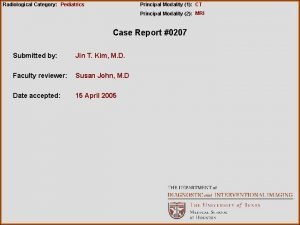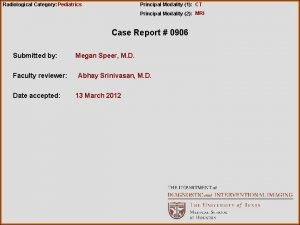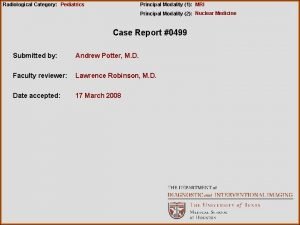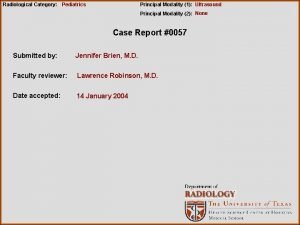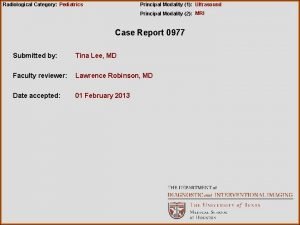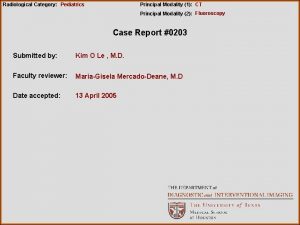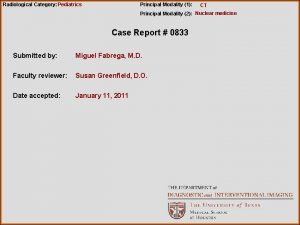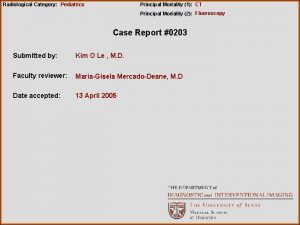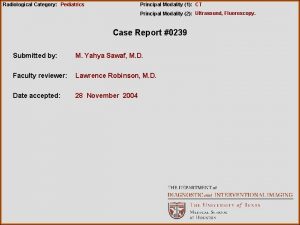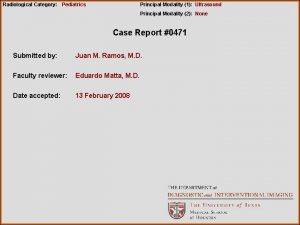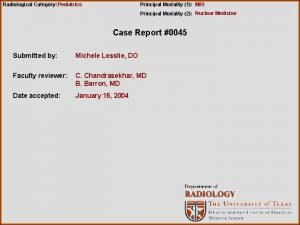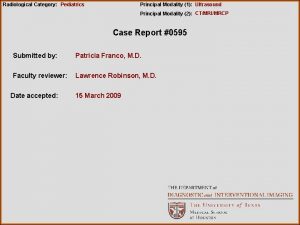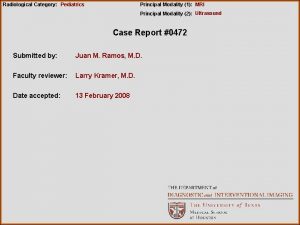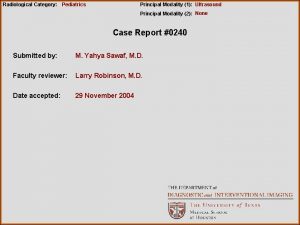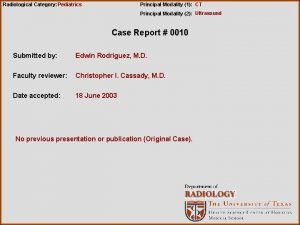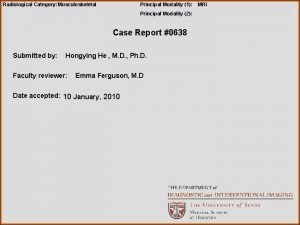Radiological Category Pediatrics Principal Modality 1 CT Principal





















- Slides: 21

Radiological Category: Pediatrics Principal Modality (1): CT Principal Modality (2): None Case Report # 0907 Submitted by: Vincent Yang , M. D. Faculty reviewer: Abhay Srinivasan, M. D Date accepted: 16 February 2012

Case History • A 15 y. o. male with past medical history of H. Pylori gastritis status post quadruple therapy and iron deficiency anemia presents with a 2 day history of severe abdominal pain, nausea, and vomiting. The vomitus is non-bloody. The patient also complains of low energy levels/fatigue for the same amount of time. • For the current episode of acute abdominal pain, there is intense pain every 5 minutes which lasts for 3 -4 minutes (essentially constant). The pain is more on the left side. There has been no bloody or black, tarry stools. • This acute pain is different from the chronic abdominal pain that the patient normally suffers from, which is crampy, epigastric in location, and somewhat relieved by antacids.

Case History • • Vitals BP 131/89 | Pulse 106 | Temp 98. 3 °F (36. 8 °C) | Resp 18 | Sp. O 2 98% • • Physical Exam Constitutional: He has a sickly appearance and appears distressed. The patient rocking back and forth, unable to find pain free position although sitting up is less painful than lying down. Cardiovascular: Slight tachycardia, normal rhythm, S 1 and S 2 Pulmonary/Chest: Effort normal and breath sounds normal. Abdominal: Generalized abdominal pain with particular tenderness to palpation in the left lower quadrant and suprapubic regions. Guarding is present. No mass is palpated. • • • Labs No leukocytosis, slight anemia with hemoglobin of 11. 4

Radiological Presentations

Radiological Presentations

Radiological Presentations

Radiological Presentations

Radiological Presentations

Radiological Presentations

Test Your Diagnosis Which one of the following is your choice for the appropriate diagnosis? After your selection, go to next page. Small bowel lymphoma Gastroenteritis Intussusception

Findings and Differentials Findings: Axial, sagittal and coronal contrast enhanced CT images of the abdomen and pelvis demonstrate a long segment of small bowel intussusception measuring approximately 25 cm in length. The intussusceptum is the ileum and portions of the mesentery and mesenteric vessels, while the intussuscepiens is the distal ileum. There is small bowel wall thickening of the involved segment. Differentials: • Lead point small bowel intussusception • Ileocolic intussusception • Transient small bowel intussusception

Discussion Ileocolic intussusception: This is the most common type of intussusception in kids, with 90% of all cases being the ileocolic type. In such cases, the distal ileum and ileocecal valve (the intussusceptum) invaginate into the more distal colon (intussuscipiens). The majority of ileocolic intussusceptions are idiopathic with the second most common cause being due to lymphoid hyperplasia. Classically, children will present with currant jelly stool, lethargy and crampy abdominal pain. The most common age group for this type of intussusception is also between 3 months and 2 years. Beyond this age group, a lead point should be suspected. Complications include bowel obstruction, ischemia and perforation, though a small percentage of cases will spontaneously reduce. Many of these cases are diagnosed by ultrasound rather than CT where there is a the “target sign” with alternating layers of hyper and hypoechogenicity which represent the hypoechoic musculature, hyperechoic mucosa and hyperechoic mesenteric fat. Treatment is either pneumatic (air) reduction or contrast reduction by barium enema though use of air is preferred due to fewer complications. Perforation and peritonitis are contraindications to reduction and the patient must go on to surgery. In the presented images, the intussusception clearly involves the distal small bowel and not the colon.

Discussion Transient small bowel intussusception: Most cases of small bowel intussusception in children are idiopathic and self limiting. A short segment of small bowel will invaginate into a more distal segment secondary to normal peristalsis. The involved segment is usually less than 3. 5 cm. This is an uncommon entity with ileocolic intussusception being far more common than small bowel intussusception. The invagination is usually transient with the intussusception spontaneously reducing. Most cases are asymptomatic, though some can present with abdominal pain, nausea and vomiting. In the presented images, there is a long segment of intussusception involving approximately 25 cm of distal small bowel. A transient intussusception would be unlikely to involve such a long segment of bowel.

Discussion Lead point small bowel intussusception: Small bowel intussusception in children which are not transient and self limiting should definitely raise suspicion for a lead point. The most common pathologic lead point is small bowel lymphoma. Other possible lead points include mass, polyp, cyst, hemorrhage, and Meckel's diverticulum. Lead point intussusception usually involves a longer segment of bowel than the idiopathic type, and is persistent. If the small bowel is more than 3. 5 cm in length, then surgery is usually needed for treatment because it will not spontaneously reduce and cannot be reduced by pneumatic or barium techniques that can be performed on ileocolic intussusception. If left untreated, it can lead to obstruction, ischemia and perforation. In the images provided, there is an intussusception involving a long segment of small bowel that measures approximately 25 cm.

Discussion Clinical course: The patient was emergently taken to the operating room and was found to have a long segment of small bowel intussusception 30 cm proximal to the terminal ileum. The involved small bowel appeared edematous and congested. Approximately 65 cm of distal ileum was resected. A 2 cm mass was identified in the serosa of the intussusceptum with hyperemia and induration, and was thought to be the lead point. Also of note, innumerable polyps were seen throughout the small bowel. The following slides are the gross specimen and microscopic images from the surgical procedure taken in the Pathology department. Subsequent colonoscopy demonstrated numerous hyperplastic polyps throughout the colon as well.

Discussion Gross specimen image: 2 cm inflammatory mass is found in intussusceptum which was thought to be the lead point of the intussusception. The surrounding ileum is hyperemic and edematous.

Discussion Microscopic slide: 2 x low power H&E stain showing the transition of normal mucosa and muscularis propria on left (thin portion) to the thickened area on right expanded by poorly defined mass (arrows)

Discussion Microscopic slide: 40 x high power of H&E stain showing the dilated vessels with RBC extravasion (blue circle), myofibroblasts (arrows) and abundant lymphocytes (black circle). Final pathologic diagnosis is inflammatory myelofibroblastic tumor

Discussion Gross specimen image: Portion of the resected ileum demonstrates innumerable tiny small bowel polyps.

Diagnosis 1. Small bowel intussusception with an inflammatory myelofibroblastic tumor as a lead point 2. Intestinal polyposis

References Del-Pozo, Gloria. Et al. Intussusception in Children: Current concepts in Diagnosis and Enema Reduction. Radiographics. 1999; 19: 299 -319 Middleton W, Kurtz A, Hertzberg B. The Requisites: Ultrasound, 2 nd Ed. 2004: 223 -223. Munden, Martha. Et al. Sonography of Pediatric Small-Bowel Intussusception: Differentiating Surgical from Nonsurgical cases. American Journal of Roentgenology. 2007; 188: 275 -279 Weissleder, Ralph. Et al. Primer of Diagnostic Imaging, 5 th Ed. 2011: 591 -592
 Pa erate
Pa erate Tennessee division of radiological health
Tennessee division of radiological health Center for devices and radiological health
Center for devices and radiological health National radiological emergency preparedness conference
National radiological emergency preparedness conference Radiological dispersal device
Radiological dispersal device Entity class in software engineering
Entity class in software engineering Epistemic modality
Epistemic modality Probalility
Probalility Data modeling fundamentals
Data modeling fundamentals Past tense in xhosa
Past tense in xhosa Modality in software engineering
Modality in software engineering Pacs modality workstation
Pacs modality workstation Modality in software engineering
Modality in software engineering Characteristics of sensory neurons
Characteristics of sensory neurons Modality
Modality Lexical vs auxiliary verbs
Lexical vs auxiliary verbs High modality examples
High modality examples Cardinality and modality
Cardinality and modality Swd modality
Swd modality Tom arbuthnot
Tom arbuthnot Epistemic modality
Epistemic modality Sodality vs modality
Sodality vs modality






















